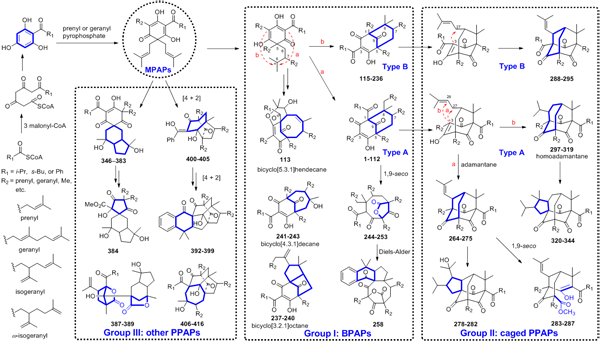

Polycyclic polyprenylated acylphloroglucinols (PPAPs), possessing highly oxygenated acylphloroglucinol-derived cores decorated with isoprenyl or geranyl side-chains, are a group of structurally fascinating and synthetically challenging natural products that collectively exhibit a broad range of biological activities.
The type of acyl groups, the number and position of isoprenyl substituents, the degree of oxidation of isoprenyl side chains and corresponding locations of etheric rings, and different types of secondary cyclization (such as aldol, Diels-Alder, etc.) create PPAPs' structural diversity and complexity.
Interestingly, this special class of hybrid natural product has been exclusively isolated from the plants of family Guttiferae with only a few exceptions. In recent years, the fascinating chemical structures and intriguing biological activities of PPAPs have attracted widespread attention in terms of organic synthesis, phytochemistry, and biological evaluation.
Prof. Xu Gang's group from the Kunming Institute of Botany, Chinese Academy of Sciences (KIB/CAS) has been committed to the investigation of the structure and bioactivity of PPAPs since 2008.
This group has investigated 16 Hypericum and Garcinia plants, published 15 kinds of PPAPs with novel skeletons, and found many PPAPs with remarkable bioactivities.
In addition, seven of their published molecules have been selected as "Hot off the press" in Natural Product Reports. Their research work promoted the research progress of natural PPAPs effectively.
In view of the contribution of Xu's team in the PPAPs field, Chemical Reviews, an authoritative review in the field of chemistry, invited them to review the progress of natural PPAPs.
This review discussed the progress of research into the chemistry and biological activity of 421 natural PPAPs, as well as in-depth studies of biological activities and total synthesis of PPAPs. In addition, all the structures of type C PPAPs were revised to corresponding type A structures and a new classification of PPAPs was provided.

Structural diverse PPAPs and their biosynthesis network (Image from KIB/CAS)
The relative or absolute configurations of some PPAPs are reassigned or critically commented upon. Furthermore, the confusing trivial names in PPAPs investigations were consolidated.
This review gives a general insight into the chemistry and biological activities of PPAPs. It not only provides a comprehensive and accurate reference for researchers but also points out challenges for pharmacological studies and organic synthesis.
The study entitled “Research Progress of Polycyclic Polyprenylated Acylphloroglucinols" has been completed and has received highly praise from peer reviewers.
Source: State Key Laboratory of Phytochemistry and Plant Resources in West China, Kunming Institute of Botany
For more information, please contact:
Yang Mei
General Office
Kunming Institute of Botany, CAS
Email: yangmei@mail.kib.ac.cn